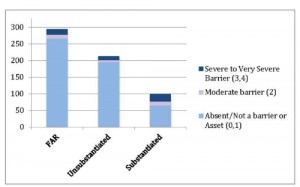The Connecticut Intensive Supportive Housing for Families (ISHF), the Connecticut grantee of the federal Partnerships to Demonstrate the Effectiveness of Supportive Housing for Families in the Child Welfare System, is using data to refine its demonstration design and advocate for lasting systems change.
The Connecticut (CT) project has three partners: the Department of Children and Families (DCF; the state child welfare agency), The Connection, Inc. (TCI; the service hub which runs the supportive housing initiative), and the University of Connecticut (UConn) evaluation team. The partners completed a 3-month pilot implementation of a “universal housing screen” with all families coming to the attention of the DCF through a child protection services investigation.
In its report on the pilot, UConn makes two key recommendations for systems change. First, the housing screen should continue to be used in the pilot site, CT DCF Region 3. Second, DCF should expand the use of the screener to the entire state – making this an institutionalized practice, not an isolated demonstration exercise.
The pilot was prompted by lower than anticipated referrals to the CT housing and child welfare project in its first three quarters of implementation.
Using the Quick Risks and Assets for Family Triage (QRAFT)1 instrument developed for the CT project, the Investigations Unit of DCF Region 3 completed a rapid appraisal of housing concerns and, when indicated, a referral to TCI on all families who experienced an investigation for maltreatment or removal of a child.
“The goal of this screening procedure was to ensure that every family underwent a housing review very early in their child welfare involvement and to enable prompt referral of families who appear to have severe to very severe housing problems,” said Jean Wigglesworth, TCI’s Project Director for ISHF. “UConn monitored the quality and process of the pilot by following all of the cases screened and consulting with the staff of the DCF investigations units, and gathering contextual data that informs the project.”
QRAFTs were completed on 616 families investigated by three different offices in DCF Region 3. Among these, most (48%) were referred to CT’s differential response system (family assessment response), 36% were unsubstantiated, and 16% (n=98) were substantiated. Less than 10 percent of the 616 families had “severe or very severe housing” problems such as frank or chronic homelessness, safety concerns, imminent eviction, current shelter stays, or imminent danger. While many more families may have had complex needs related to mental illness, trauma, substance abuse, and/or domestic violence, the majority had no or moderate housing problems at the time of the child protection investigation.
Among the 98 cases that were substantiated, however, 21% had severe to very severe housing concerns and another 12% had housing challenges considered to be unsustainable (e.g., above 30% of income, safety concerns, instability). Families with substantiated child welfare reports experienced significantly more housing instability than the other two groups.
Not all who had severe or very severe housing problems also had other challenges that rendered them eligible for the randomized study. Those families are referred to the state’s existing supportive housing program.
Ultimately, 12 families met all the targeted eligibility criteria for the demonstration, which is intended to reach families in the child welfare system with the most significant challenges in housing as well as parent and child functioning. As a result of the QRAFT pilot, the demonstration did experience a greater proportion of referrals that were appropriate than had been experienced before the pilot. It’s important to note that most referrals to the CT project come through the child welfare program, rather than the shelter system; rates and severity of housi ng concerns will always reflect the specifics of the population under study.
ng concerns will always reflect the specifics of the population under study.
UConn also interviewed child welfare leadership and social work staff in DCF Region 3 to understand how their experiences with the pilot and obtain feedback on “what worked, challenges experienced, and recommendations for future implementation at other sites across the state.” These interviews produced helpful insights including “the QRAFT was easy to use, brought housing stability to the forefront in the initial assessment process, and facilitated conversations about housing history.” It also gave staff a better, more concrete method for targeting the appropriate families for this very intensive supportive housing service.
Expanding the use of the QRAFT statewide will not only inform the CT demonstration, it will enable a statewide examination of the apparent extent of housing instability and crisis among families referred for child welfare investigations.
CSH and the Center for the Study of Social Policy co-lead a Child Welfare and Supportive Housing Resource Center, tasked with providing technical support and best practices while helping grantees develop new, multi-system responses to families at risk of long-term public system engagement and having children placed in foster care.
For more information on CT’s implementation of the Administration on Children, Youth, and Families (ACYF) Partnerships to Demonstrate the Effectiveness of Supportive Housing for Families in the Child Welfare System, click here.
Thanks to Sarah Morrison at the Center for the Study of Social Policy for authoring and contributing this piece. The source for this report is Farrell et al., Universal Screening of Families Undergoing Child Welfare Investigation: Technical Report on CT’s Pilot of the QRAFT. March 9, 2015, University of Connecticut, Center for Applied Research.
1. The QRAFT is an abbreviated version of the Risks and Assets for Family Triage (RAFT®) tool originally developed to inform screening on entry to CT’s Supportive Housing for Families program. ®The Connection, Inc.
